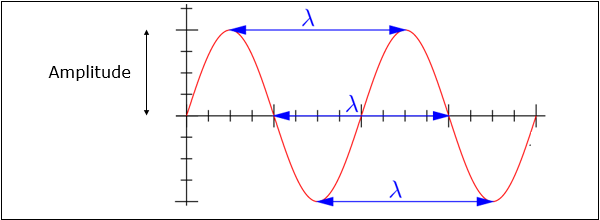|
The basic communication parameters are discussed in this chapter to have a better idea about the wireless communication using antennas. The wireless communication is done in the form of waves. Hence, we need to have a look at the properties of waves in the communications.
In this chapter, we are going to discuss about the following parameters −
- Frequency
- Wavelength
- Impedance matching
- VSWR & reflected power
- Bandwidth
- Percentage bandwidth
- Radiation intensity
Now, let us learn them in detail.
Frequency
According to the standard definition, “The rate of repetition of a wave over a particular period of time,
is called as frequency.”
Simply, frequency refers to the process of how often an event occurs. A periodic wave repeats
itself after every ‘T’ seconds (time period). Frequencyof periodic wave is nothing but the reciprocal
of time period (T).
Mathematical Expression
Mathematically, it is written as shown below.
f=1T
Where
Units
The unit of frequency is Hertz, abbreviated as 
The figure given above represents a sine wave, which is plotted here for Voltage in millivolts against time in milliseconds. This wave repeats after every 2t milliseconds. So, time period, T=2t milliseconds and frequency, f=12TKHz
Wavelength
According to the standard definition, “The distance between two consecutive maximum points (crests) or between two consecutive minimum points (troughs) is known as the wavelength.”
Simply, the distance between two immediate positive peaks or two immediate negative peaks is nothing but the length of that wave. It can be termed as the Wavelength.
The following figure shows a periodic waveform. The wavelength (λ) and amplitude are denoted in the figure. The higher the frequency, the lesser will be the wavelength and vice versa.

Mathematical Expression
The formula for wavelength is,
λ=cf
Where
λ is the wavelength
c is the speed of light (3∗108 meters/second)
f is the frequency
Units
The wavelength λ is expressed in the units of length such as meters, feet or inches. The commonly used term is meters.
Impedance Matching
According to the standard definition, “The approximate value of impedance of a transmitter, when equals the approximate value of the impedance of a receiver, or vice versa, it is termed as Impedance matching.”
Impedance matching is necessary between the antenna and the circuitry. The impedance of the antenna, the transmission line, and the circuitry should match so that maximum power transfer takes place between the antenna and the receiver or the transmitter.
Necessity of Matching
A resonant device is one, which gives better output at certain narrow band of frequencies. Antennas are such resonant devices whose impedance if matched, delivers a better output.
The power radiated by an antenna, will be effectively radiated, if the antenna impedance matches the free space impedance.
For a receiver antenna, antenna’s output impedance should match with the input impedance of the receiver amplifier circuit.
For a transmitter antenna, antenna’s input impedance should match with transmitter amplifier’s output impedance, along with the transmission line impedance.
Units
The unit of impedance (Z) is Ohms.
VSWR & Reflected Power
According to the standard definition, “The ratio of the maximum voltage to the minimum voltage in a standing wave is known as Voltage Standing Wave Ratio.”
If the impedance of the antenna, the transmission line and the circuitry do not match with each other, then the power will not be radiated effectively. Instead, some of the power is reflected back.
The key features are −
The term, which indicates the impedance mismatch is VSWR.
VSWR stands for Voltage Standing Wave Ratio. It is also called as SWR.
The higher the impedance mismatch, the higher will be the value of VSWR.
The ideal value of VSWR should be 1:1 for effective radiation.
Reflected power is the power wasted out of the forward power. Both reflected power and VSWR indicate the same thing.
Bandwidth
According to the standard definition, “A band of frequencies in a wavelength, specified for the particular communication, is known as bandwidth.”
The signal when transmitted or received, is done over a range of frequencies. This particular range of frequencies are allotted to a particular signal, so that other signals may not interfere in its transmission.
Bandwidth is the band of frequencies between the higher and lower frequencies over which a signal is transmitted.
The bandwidth once allotted, cannot be used by others.
The whole spectrum is divided into bandwidths to allot to different transmitters.
The bandwidth, which we just discussed can also be called as Absolute Bandwidth.
Percentage Bandwidth
According to the standard definition, “The ratio of absolute bandwidth to the center frequency of that bandwidth can be termed as percentage bandwidth.”
The particular frequency within a frequency band, at which the signal strength is maximum, is called as resonant frequency. It is also called as center frequency (fC) of the band.
The higher and lower frequencies are denoted as fH and fLrespectively.
The absolute bandwidth is given by- fH - fL.
To know how wider the bandwidth is, either fractional bandwidth or percentage bandwidth has to be calculated.
Mathematical Expression
The Percentage bandwidth is calculated to know how much frequency variation either a component or a system can handle.
Percent |
 Home
|
News
|
Photogallery
Home
|
News
|
Photogallery
 Home
|
News
|
Photogallery
Home
|
News
|
Photogallery